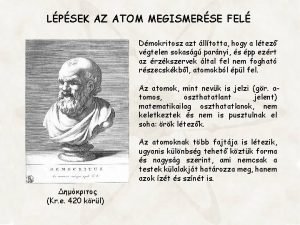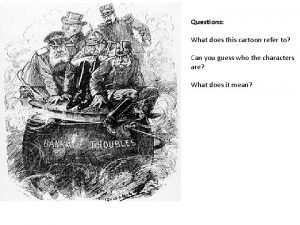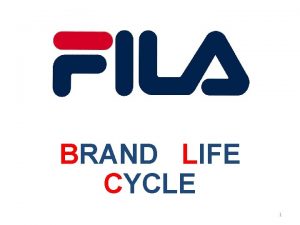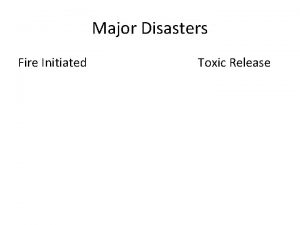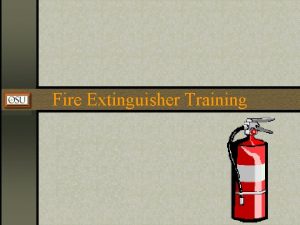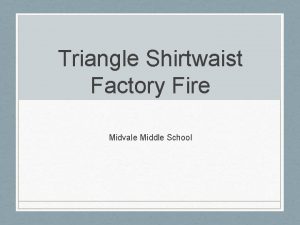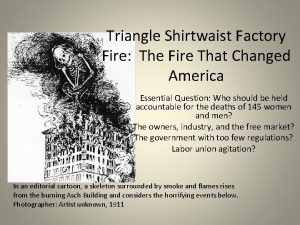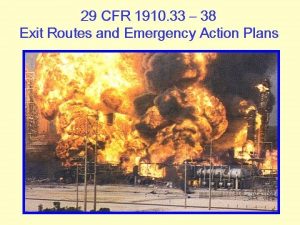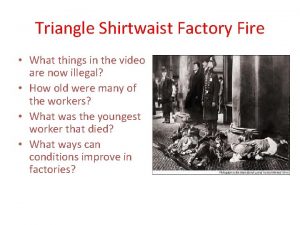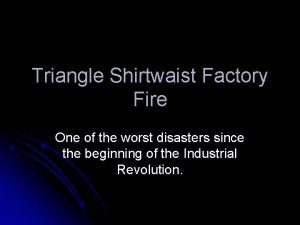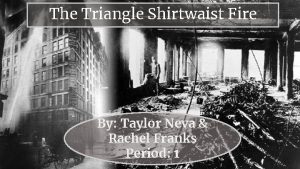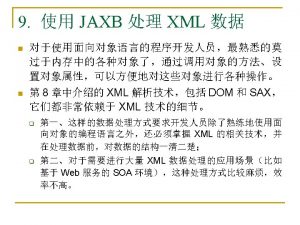Triangle Shirtwaist Factory Fire March 25 1911 From




























- Slides: 28


Triangle Shirtwaist Factory Fire (March 25, 1911) From Lovell, Moberly, Watkins, Esqs. MSHS Sweatshop Industries, Inc.

The Triangle Shirtwaist Factory fire in New York City on March 25, 1911, was the largest industrial disaster in the history of the city of New York, causing the death of 146 garment workers who either died in the fire or jumped to their deaths. The fire led to legislation requiring improved factory safety standards and helped spur the growth of the International Ladies' Garment Workers' Union, which fought for better working conditions for sweatshop workers in that industry.

The Triangle Shirtwaist Company, owned by Max Blanck and Isaac Harris, occupied the top three floors of the ten-story Asch building in New York City at the intersection of Greene Street and Washington Place, just east of Washington Square. The company employed approximately 500 workers, mostly young immigrant women from Italy and Eastern Europe. Some of the women were as young as twelve or thirteen and worked fourteenhour shifts during a 60 -hour to 72 -hour workweek, sewing clothes for a wage of $1. 50 per week (approximately $31 per week in 2006 dollars).

The Triangle Shirtwaist Company had already become well-known outside the garment industry by 1911: the massive strike by women's shirtwaist makers in 1909, known as the Uprising of 20, 000, began with a spontaneous walkout at the Triangle Company.

While the International Ladies' Garment Workers' Union negotiated a collective bargaining agreement covering most of those workers after a four-month strike, Triangle Shirtwaist refused to sign the agreement.

The conditions of the factory were typical of the time. Flammable textiles were stored throughout the factory, scraps of fabric littered the floors, patterns and designs on sheets of tissue paper hung above the tables, smoking was common, illumination was provided by open gas lighting, and there were no fire extinguishers.

In the afternoon of March 25, 1911, a fire began on the eighth floor, possibly sparked by a lighted match or a cigarette. A New York Times article also theorized that the fire may have been started by the engines running the sewing machines in the building. To this day, no one knows whether it was accidental or intentional. Most of the workers who were alerted on the tenth and eighth floors were able to evacuate. However the warning about the fire did not reach the ninth floor in time.

The ninth floor had only two doors leading out. One stairwell was already filling with smoke and flames by the time the seamstresses realized the building was ablaze. The other door had been locked, ostensibly to prevent workers from stealing materials or taking breaks and to keep out union organizers.

The single exterior fire escape, a flimsy, poorlyanchored iron structure, soon twisted and collapsed under the weight of people trying to escape. The elevator also stopped working, cutting off that means of escape, partly because the panicked workers tried to save themselves by jumping down the shaft to land on the roof of the elevator.

Realizing there was no other way to avoid the flames, sixty-two of the women broke windows and jumped to the pavement nine floors below. Others pried open the elevator doors and tumbled down the elevator shaft. Of the jumpers, a single survivor was found close to drowning in water collecting in the elevator shaft. The fallen bodies and falling victims made it difficult for the fire department to reach the building. The remainder waited until smoke and fire overcame them. The fire department arrived quickly but was unable to stop the flames, as there were no ladders available that could reach beyond the sixth floor. The death toll was 146.

The company's owners, Max Blanck and Isaac Harris, had fled to the building's roof when the fire began and survived. They were later put on trial, at which Max Steuer, counsel for the defendants, managed to destroy the credibility of one of the survivors, Kate Alterman, by asking her to repeat her testimony a number of times — which she did, without altering a single word. Steuer argued to the jury that Alterman and probably other witnesses had memorized their statements and might even have been told what to say by the prosecutors. The defense also stressed that the prosecution had failed to prove that the owners knew the exit doors were locked at the time in question. The jury acquitted the owners. However, they lost a subsequent civil suit in 1913, and plaintiffs won compensation in the amount of $75 per deceased victim.

Cartoon pointing out the horrid working conditions at Triangle Shirtwaist Factory


Cartoon point out the corruption inherent in the inspection of the Triangle Shirtwaist Factory by city officials.

Firefighters returned the few belongings they could find.




Picture taken soon after fire was extinguished on ninth floor.

Picture taken after clean up began on the ninth floor.






A family member walks out of temporary morgue after viewing remains of victim

Small Group Activity w With the white boards, develop a solution plan to these types of problems. – Minimum of 6 new rules/laws w Group Roles – Recorder – Reporter – Time Keeper w You have 8 minutes and then you’re reporter will report back to the class.
 The triangle shirtwaist factory fire commonlit answer key
The triangle shirtwaist factory fire commonlit answer key Triangle shirtwaist factory fire led to which reforms
Triangle shirtwaist factory fire led to which reforms Triangle shirtwaist fire jumpers
Triangle shirtwaist fire jumpers Triangle shirtwaist fire apush definition
Triangle shirtwaist fire apush definition Flesh and blood so cheap
Flesh and blood so cheap Anthem of poland
Anthem of poland Java factory factory joke
Java factory factory joke Atommodell 1911
Atommodell 1911 The first cartoons
The first cartoons Ireland 1911
Ireland 1911 Moroccan crisis 1911
Moroccan crisis 1911 Modelo atomico de dalton
Modelo atomico de dalton Ireland 1911
Ireland 1911 Niagara falls frozen 1911
Niagara falls frozen 1911 Fila heritage 1911
Fila heritage 1911 1911 - 1988
1911 - 1988 Moroccan crisis cartoon
Moroccan crisis cartoon Revelation 1911
Revelation 1911 Sonormuseum
Sonormuseum Race fire safety
Race fire safety Canvas connection hvac
Canvas connection hvac Uttar pradesh fire prevention & fire safety rules, 2005
Uttar pradesh fire prevention & fire safety rules, 2005 Rwi are
Rwi are Reichstag fire who was the fire starter
Reichstag fire who was the fire starter Pressure gauge for water
Pressure gauge for water Fire triangle
Fire triangle Triangle fire extinguisher
Triangle fire extinguisher Tetrahedron fire triangle
Tetrahedron fire triangle Basic fire fighting training ppt
Basic fire fighting training ppt







